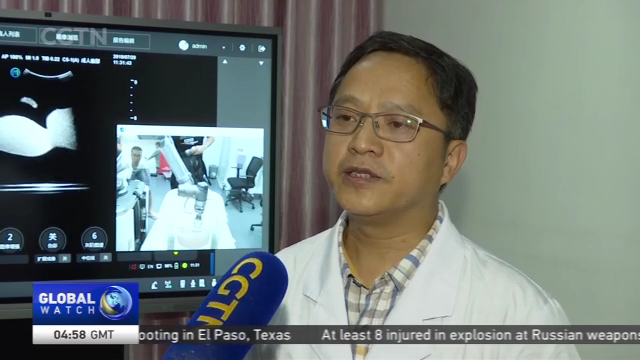
13:19, 06-Aug-2019
5G Beyond the Smartphone: A look at how next-generation tech is used in different ways
Updated
13:30, 06-Aug-2019

Chinese tech giant Huawei is going beyond smartphones when it comes to their 5G technology. The company has partnered with transportation authorities and hospitals across China, aiming to expand the application and usage of the next era of networks and communication. CGTN's Omar Khan brings us more on the diverse ways 5G is making an impact.
5G is often geared and marketed to consumers as the next generation technology for our smartphones. But for Huawei, their push into the 5G era is going beyond mobile devices.
The tech giant has partnered with various companies around China, including transport authorities in the southwestern Chinese city of Chengdu.
Here the city's second ring road is fully covered by a 5G network.
ZHAO XUEYAO 5G BUS ACCOUNT MANAGER "We now see the first 5G bus series in China. It has two characteristics, first, it is 5G standalone network enabled. Second, it is the longest bus route in the country with 5G coverage, stretching for 28 kilometers. The bus is fitted with several major applications, including 5G powered 4K and 8K TVs. These buses can bring us a better experience."
The Chengdu bus line is the largest SA network in China, meaning it's specifically made for 5G transmission.
On this demo bus, we're able to experience 5G speeds, as we drive around the city.
The application of 5G technology has also entered the medical field, helping both doctors and patients.
OMAR KHAN CHENGDU, SICHUAN PROVINCE "When 5g is mentioned, people often think of how it's going to revolutionize our mobile phone experience. But here at the third people's hospital of Chengdu, doctors are using a 5G network to conduct long distance consultations. Highlighting how the technology can be applied to a variety of different cases."
The remote consultation center allows doctors to perform ultra-sonography tests from afar.
Experts say the tests can be conducted with precision, and that professional advice can be provided instantaneously.
ZHOU HONG, CHIEF PHYSICIAN THIRD PEOPLE'S HOSPITAL OF CHENGDU "5G technology features high bandwidth, low latency, and a high transmission rate, enabling areas of telemedicine that were previously impossible to implement. For example, in the case of ultrasound tests, we can conduct real-time remote consultations in remote mountainous areas through real-time transmission across 5G networks."
Here at the Chengdu hospital, doctors can control a mechanical arm all the way in Shenzhen.
They believe the rewards greatly outweigh the potential risks.
ZHOU HONG, CHIEF PHYSICIAN THIRD PEOPLE'S HOSPITAL OF CHENGDU "If we are only using it as a remote consultation procedure, then there is no risk. Like a remote ultrasound robot, when we set it up, it also sets a certain pressure. When the probe is pressed against the patient's body, its maximum pressure is controllable. This will ensure the safety of the patient."
In the near future, public transportation may allow people to become as productive as when they are in an office. And for the medical field, the ability to work remotely will further remove limits for the practice.
All thanks, to 5G.
Omar Khan, CGTN, Chengdu.
SITEMAP
Copyright © 2018 CGTN. Beijing ICP prepared NO.16065310-3
Copyright © 2018 CGTN. Beijing ICP prepared NO.16065310-3